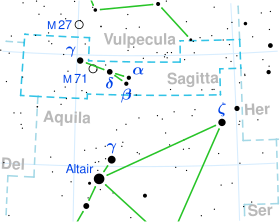| Observation data Epoch J2000.0 Equinox J2000.0 | |
|---|---|
| Constellation | Sagitta |
| Right ascension | 19h 57m 45.44547s [1] |
| Declination | +16° 47′ 20.9781″ [1] |
| Apparent magnitude (V) | 5.53 [2] |
| Characteristics | |
| Spectral type | B9III [3] |
| Astrometry | |
| Radial velocity (Rv) | −26.10±1.6 [4] km/s |
| Proper motion (μ) |
RA: 11.609
[1]
mas/
yr Dec.: 18.605 [1] mas/ yr |
| Parallax (π) | 7.5596 ± 0.0600 mas [1] |
| Distance | 431 ± 3
ly (132 ± 1 pc) |
| Details | |
| Mass | 2.47 [2] M☉ |
| Radius | 4.02 [2] R☉ |
| Luminosity | 127 [2] L☉ |
| Surface gravity (log g) | 3.62 [2] cgs |
| Temperature | 9,661 [2] K |
| Metallicity [Fe/H] | 0.0 [5] dex |
| Rotational velocity (v sin i) | 34 [6] km/s |
| Age | 242 [5] Myr |
| Other designations | |
| Database references | |
| SIMBAD | data |
11 Sagittae is a star in the constellation Sagitta. It is a blue giant with a spectral classification of B9III and has evolved off the main sequence.
Naming
It is in the Chinese asterism 左旗 (Zuǒ Qí), or Left Flag which consists of 11 Sagittae, γ Sagittae, α Sagittae, β Sagittae, δ Sagittae, ζ Sagittae, 13 Sagittae, 14 Sagittae and ρ Aquilae. Consequently, the Chinese name for γ Sagittae itself is 左旗七 (Zuǒ Qí qī, English: the Seventh Star of Left Flag).[ citation needed]
References
- ^ a b c d e Brown, A. G. A.; et al. (Gaia collaboration) (2021). "Gaia Early Data Release 3: Summary of the contents and survey properties". Astronomy & Astrophysics. 649: A1. arXiv: 2012.01533. Bibcode: 2021A&A...649A...1G. doi: 10.1051/0004-6361/202039657. S2CID 227254300. (Erratum: doi: 10.1051/0004-6361/202039657e). Gaia EDR3 record for this source at VizieR.
- ^ a b c d e f Stassun, Keivan G.; et al. (2019-10-01). "The Revised TESS Input Catalog and Candidate Target List". The Astronomical Journal. 158 (4): 138. arXiv: 1905.10694. Bibcode: 2019AJ....158..138S. doi: 10.3847/1538-3881/ab3467. hdl: 1721.1/124721. ISSN 0004-6256. S2CID 166227927.
- ^ a b "11 Sge". SIMBAD. Centre de données astronomiques de Strasbourg. Retrieved 2022-02-26.
- ^ Gontcharov, G. A. (2006). "Pulkovo Compilation of Radial Velocities for 35 495 Hipparcos stars in a common system". Astronomy Letters. 32 (11): 759–771. arXiv: 1606.08053. Bibcode: 2006AstL...32..759G. doi: 10.1134/S1063773706110065. S2CID 119231169.
- ^ a b Gontcharov, G. A. (2012). "Dependence of kinematics on the age of stars in the solar neighborhood". Astronomy Letters. 38 (12): 771–782. arXiv: 1606.08814. Bibcode: 2012AstL...38..771G. doi: 10.1134/S1063773712120031. S2CID 118345778.
- ^ Abt, Helmut A.; Levato, Hugo; Grosso, Monica (2002). "Rotational Velocities of B Stars". The Astrophysical Journal. 573 (1): 359–365. Bibcode: 2002ApJ...573..359A. doi: 10.1086/340590.
| Observation data Epoch J2000.0 Equinox J2000.0 | |
|---|---|
| Constellation | Sagitta |
| Right ascension | 19h 57m 45.44547s [1] |
| Declination | +16° 47′ 20.9781″ [1] |
| Apparent magnitude (V) | 5.53 [2] |
| Characteristics | |
| Spectral type | B9III [3] |
| Astrometry | |
| Radial velocity (Rv) | −26.10±1.6 [4] km/s |
| Proper motion (μ) |
RA: 11.609
[1]
mas/
yr Dec.: 18.605 [1] mas/ yr |
| Parallax (π) | 7.5596 ± 0.0600 mas [1] |
| Distance | 431 ± 3
ly (132 ± 1 pc) |
| Details | |
| Mass | 2.47 [2] M☉ |
| Radius | 4.02 [2] R☉ |
| Luminosity | 127 [2] L☉ |
| Surface gravity (log g) | 3.62 [2] cgs |
| Temperature | 9,661 [2] K |
| Metallicity [Fe/H] | 0.0 [5] dex |
| Rotational velocity (v sin i) | 34 [6] km/s |
| Age | 242 [5] Myr |
| Other designations | |
| Database references | |
| SIMBAD | data |
11 Sagittae is a star in the constellation Sagitta. It is a blue giant with a spectral classification of B9III and has evolved off the main sequence.
Naming
It is in the Chinese asterism 左旗 (Zuǒ Qí), or Left Flag which consists of 11 Sagittae, γ Sagittae, α Sagittae, β Sagittae, δ Sagittae, ζ Sagittae, 13 Sagittae, 14 Sagittae and ρ Aquilae. Consequently, the Chinese name for γ Sagittae itself is 左旗七 (Zuǒ Qí qī, English: the Seventh Star of Left Flag).[ citation needed]
References
- ^ a b c d e Brown, A. G. A.; et al. (Gaia collaboration) (2021). "Gaia Early Data Release 3: Summary of the contents and survey properties". Astronomy & Astrophysics. 649: A1. arXiv: 2012.01533. Bibcode: 2021A&A...649A...1G. doi: 10.1051/0004-6361/202039657. S2CID 227254300. (Erratum: doi: 10.1051/0004-6361/202039657e). Gaia EDR3 record for this source at VizieR.
- ^ a b c d e f Stassun, Keivan G.; et al. (2019-10-01). "The Revised TESS Input Catalog and Candidate Target List". The Astronomical Journal. 158 (4): 138. arXiv: 1905.10694. Bibcode: 2019AJ....158..138S. doi: 10.3847/1538-3881/ab3467. hdl: 1721.1/124721. ISSN 0004-6256. S2CID 166227927.
- ^ a b "11 Sge". SIMBAD. Centre de données astronomiques de Strasbourg. Retrieved 2022-02-26.
- ^ Gontcharov, G. A. (2006). "Pulkovo Compilation of Radial Velocities for 35 495 Hipparcos stars in a common system". Astronomy Letters. 32 (11): 759–771. arXiv: 1606.08053. Bibcode: 2006AstL...32..759G. doi: 10.1134/S1063773706110065. S2CID 119231169.
- ^ a b Gontcharov, G. A. (2012). "Dependence of kinematics on the age of stars in the solar neighborhood". Astronomy Letters. 38 (12): 771–782. arXiv: 1606.08814. Bibcode: 2012AstL...38..771G. doi: 10.1134/S1063773712120031. S2CID 118345778.
- ^ Abt, Helmut A.; Levato, Hugo; Grosso, Monica (2002). "Rotational Velocities of B Stars". The Astrophysical Journal. 573 (1): 359–365. Bibcode: 2002ApJ...573..359A. doi: 10.1086/340590.
